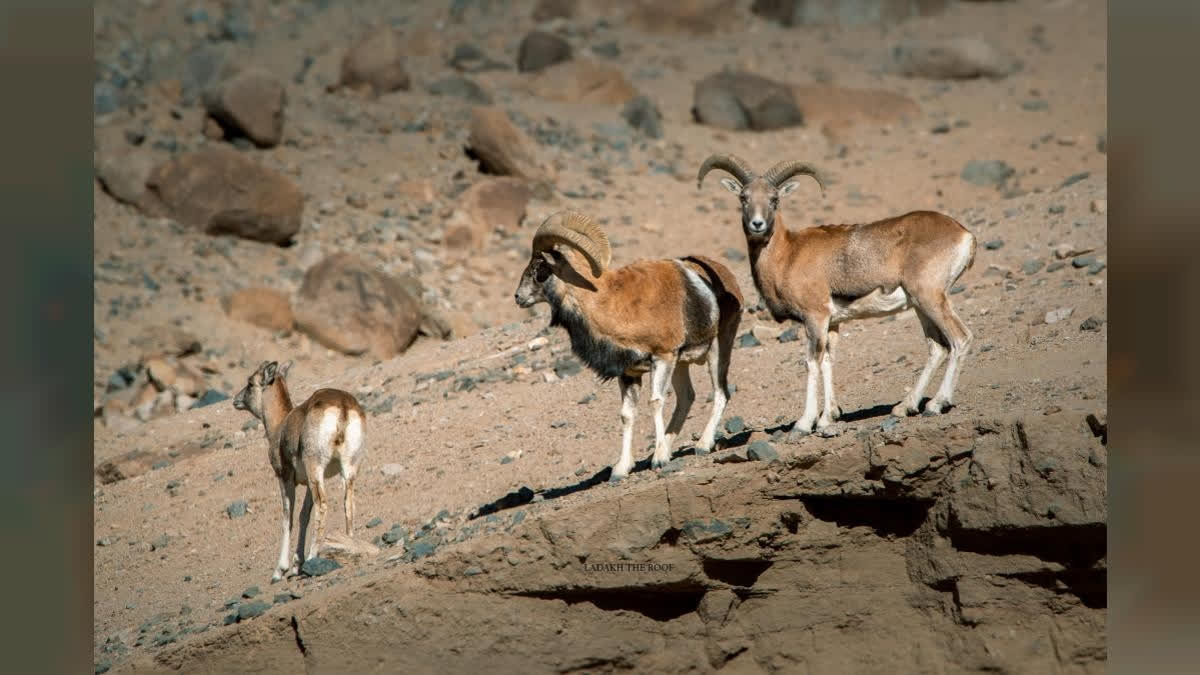Leh: When trying to experience and sight wildlife in Ladakh, one of the easiest animals to spot is the Ladakh Urial, a wild sheep endemic to the cold desert of Ladakh. It is a subspecies of the wild sheep native to Central and South Asia known as Urial. This rare species of Urial is usually found in the Western part of Ladakh, mostly in the Sham and Nubra regions. The Ladakhi folks know it by the name of Shapo and it stays at a height of 3000m to 4500m. The distinguishing features of the Ladakh Urial include big rounded semi-circle horns and a smooth hairy patch between the chin and the underbelly in the male category and the females have small horns with both not being able to run that fast.
However, while one might think it is easily sightable, it is alarming to know that it is listed as vulnerable in the IUCN red list of threatened species. The IUCN or International Union for Conservation of Nature is an international organisation working in the field of nature conservation and sustainable use of natural resources. The IUCN red list aims to inform and catalyse biodiversity conservation and policy change. On the national level, the Ladakh Urial falls under the Schedule-I category of endangered species under the Wildlife Protection Act 1972.
Having come under both these lists, the Ladakh Urial has been saved from the menace of hunting but the population still faces major threats and their sightings have become rarer. Mohammad Arhaan, a young wildlife photographer from Leh shares his experience of how people don't value this endemic species and treat them as just another mountain animal.
He says, "People have started building houses and concrete structures on the mountains which is the common habitat for the Ladakh Urial. Due to this they end up moving to higher terrain and as they are not used to the elevation, it may pose a risk to them but they have no option. Also while hunting is prohibited there are still cases where the Ladakh Urial is hunted because as it dwells on the lower terrain, it is the easiest to hunt."
He added that the local people need to understand that the Ladakh Urial is only found in Ladakh and not anywhere else which makes it very special. This was also shared by Mohd Imran who has been filming wildlife for 10 years and is an indigenous wildlife filmmaker and founder of Shan Productions.
He says, "I have spotted Ladakh Urial in groups of 30 as well as in groups of 40 but currently this species faces major threats specially from feral dogs who prey on the young ones who are not able to protect themselves as they are used to staying on the plateaus and are not able to run on the rocky terrains when chased by these feral dogs. As they tend to dwell near water bodies they are also easy targets of poaching."
While these are observations made by professionals who have been in the field, there still seems to be a need for a proper study to understand their decline in numbers. Gulzar Hussain a naturalist from Ladakh says that a proper study on the Ladakh Urial is still pending.
He said, "Due to its habitat being on the lower altitude it is an easy prey for the snow leopard. There might also be the case of a disease outbreak as the Ladakh Urial often mingles with the livestock and in such a situation one might never know when an infectious disease has spread."
Lobzang Visuddha, chairman of the Wildlife Conservation and Birds Club of Ladakh (WCBCL) said that the causes for the decline of the only endemic mammal of Ladakh have all been introduced by humans. He says, "Humans first hunted the Ladakh Urial for meat and horns, then when hunting was banned, humans introduced feral dogs into their habitat and on top of that they suffered a loss of habitat due to human encroachment." "Currently though, according to me the population of Ladakh Urial is now stable in Ladakh," he added.
Smanla Tsering, who works with the Wildlife Department as a Wildlife Guard highlighted that awareness among the villagers is very important. He shared that the department creates awareness among the villagers about the importance of the food chain and encourages them to help protect the Ladakh Urial.
He says, "When we make the villagers aware they understand the importance and whenever they find the Ladakh Urial injured or being chased by feral dogs, they immediately inform the department." Speaking about the threats that the Ladakh Urial faces, he added, "Less snowfall is impacting vegetation growth in the mountains which is a major food source for them. Additionally, an increase in human settlement especially around water sources has left them with no corridors to travel and exposes them to the risk of crossing highway roads."
To protect this rare species, Gulzar Hussain and Mohd Imran both emphasised that community contribution is a must. Gulzar Hussain says, "Ladakh is a very vast region and it becomes difficult for the officials to keep track of everything. It should be the villagers who should come together and take measures to ensure that the Ladakh Urial is protected and its habitat is not destroyed. Actions like this at the ground level will be much more impactful.”



